Long acting reversible contraception
 |
Contraceptive Injection |
| Description | Long-acting injection of progestogen |
| Efficacy* | Perfect use: 99% effective | Typical use: around 94% |
| Mode of Action | Steady release of progestogen that prevents ovulation, thickens cervical mucus and thins uterine lining to reduce likelihood of implanting of fertilised egg |
| Instructions | Injected into arm or abdomen and lasts for 8–13 weeks (varies depending on contraceptive) |
| Advantages | - Don’t have to remember about contraception for as long as the injection lasts - Not affected by other medicines - May reduce heavy painful periods and help with premenstrual symptoms for some people - Can be used while breastfeeding - Doesn’t contain oestrogen |
| Disadvantages | - Irregular bleeding may continue for some months after you stop the injections - Potential weight gain - It can’t be removed from your body, so any side effects can continue for the full 8-13 weeks - There can be a delay of up to one year before the return of periods and fertility after stopping the injection - No protection against STIs - Some people experience side effects such as spotty skin, hair loss, decreased libido, mood swings and headaches |
 |
Intra-uterine device (IUD) |
| Description | A T-shaped plastic or copper device inserted into the uterus |
| Efficacy* | Perfect use: 99% effective | Typical use: around 99% |
| Mode of action | Releases copper to alter cervical mucus and reduce likelihood of implanting of fertilised egg |
| Instructions | Inserted by doctor or nurse and lasts for 5–10 years. Can be inserted at any stage in the cycle and gives immediate protection. For older women, it can be left in until menopause |
| Advantages | - Don’t have to remember to use it - Works immediately - Works for 5 or 10 years, depending on type - Can be used while breastfeeding - Not affected by other medicines - Fertility returns to normal as soon as the IUD is taken out |
| Disadvantages | - Periods may be heavier, longer or more painful. This may improve after a few months - An internal examination required when the IUD is fitted - Does not protect from STIs - Doesn’t increase your risk of infection, but if an infection occurs when an IUD is in place this could lead to a pelvic infection if it isn’t treated |
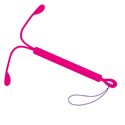 |
Intra-uterine system (IUS) |
| Description | A T-shaped plastic device that releases progestogen (levonorgestrel) and is inserted into the uterus |
| Efficacy* | Perfect use: 99% effective | Typical use: around 99% |
| Mode of action | Releases progestogen to thicken cervical mucus and thin uterine lining to reduce likelihood of implanting of fertilised egg. May also prevent ovulation in some cases |
| Instructions | Inserted into the uterus via the cervix and lasts for 3–5 years. If inserted in the first 7 days of the cycle gives immediate protection. For older women, it can be left in until menopause |
| Advantages | - Don’t have to remember to use it - Periods usually become much lighter and shorter, and sometimes less painful. They may stop completely after the first year of use - Works for 3, 4 or 5 years depending on type - Can be used while breastfeeding - Doesn’t contain oestrogen - Fertility returns to normal as soon as the IUS is taken out - Not affected by other medicines Mirena can be used to protect the lining of your uterus (womb) if you’re having HRT |
| Disadvantages | - Period changes may occur - Some people may get side effects such as acne, headaches or breast tenderness. These usually get better after the first few months - Some people develop small fluid-filled cysts on their ovaries that may cause pain. These aren’t dangerous and usually don’t need treatment - An internal examination required when the IUS is fitted - Doesn’t protect from STIs |
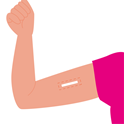 |
Contraceptive implant |
| Description | A small flexible rod that releases progestogen |
| Efficacy* | Perfect use: 99% effective | Typical use: around 99% |
| Mode of action | Releases progestogen to thicken cervical mucus and thin uterine lining to reduce likelihood of implanting of fertilised egg |
| Instructions | Inserted under the skin and lasts for 3 years |
| Advantages | - Don’t have to remember about contraception for as long as the implant lasts - Works for 3 years - May reduce heavy, painful periods - Can be used while breastfeeding - Fertility will return to normal as soon as the implant is taken out |
| Disadvantages | - Period changes may occur - May experience temporary side effects when first inserted.These should stop within a few months. They may include headaches, breast tenderness and mood changes - May get acne or acne may get worse - Not suitable if using enzyme-inducing drugs as these can make the implant less effective - Requires a small procedure to fit and remove it - Doesn't protect from STIs |
 |
Vaginal ring |
| Description | Soft plastic ring containing combined oestrogen and progestogen inserted inside the vagina |
| Efficacy* | Perfect use: 99% effective | Typical use: around 91% |
| Mode of action | Releases continuous dose of oestrogen and progestogen, which is absorbed systemically to prevent ovulation. Also thickens cervical mucus and thins uterine lining to reduce likelihood of implanting of fertilised egg |
| Instructions | Inserted into the vagina for 3 weeks and removed for one week (to allow for monthly bleed). A new ring is inserted after that |
| Advantages | - Don’t have to remember it every day - Easy to insert and remove - Not affected by vomiting or diarrhoea - Usually makes bleeds more regular, lighter and less painful - May help with premenstrual symptoms - Reduces the risk of cancer of the ovary, uterus and colon - May reduce menopausal symptoms - May reduce the risk of recurrent endometriosis after surgery - Helps with problems associated with polycystic ovarian syndrome (PCOS) |
| Disadvantages | - May not feel comfortable inserting and removing it - May get temporary side effects at first, including increased vaginal discharge, headaches, nausea, breast tenderness and mood change - Breakthrough bleeding and spotting (unexpected vaginal bleeding on days you’re using the ring) may occur in the first few months of use - Doesn’t protect against STIs |
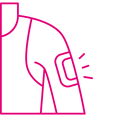 |
Contraceptive patch |
| Description | Transdermal patch containing oestrogen and progestogen |
| Efficacy* | Perfect use: 99% effective | Typical use: around 91% |
| Mode of action | Releases continuous dose of oestrogen and progestogen, which is absorbed systemically to prevent ovulation. Also thickens cervical mucus and thins uterine lining to reduce likelihood of implanting of fertilised egg |
| Instructions | One patch applied to skin weekly for 3 weeks with one week off (to allow for monthly bleed). Not to be applied to breast or sore skin |
| Advantages | - Don’t have to remember it everyday - Easy to use and remove - Not affected by vomiting or diarrhoea - Usually makes bleeds more regular, lighter and less painful - May help with premenstrual symptoms - Reduces the risk of cancer of the ovary, uterus and colon - May reduce menopausal symptoms - May reduce the risk of recurrent endometriosis after surgery - Helps with problems associated with PCOS |
| Disadvantages | - Can be seen - May cause skin irritation - May get temporary side effects at first, including increased vaginal discharge, headaches, nausea, breast tenderness and mood change - Breakthrough bleeding and spotting (unexpected vaginal bleeding when using) may occur in the first few months of use - Doesn’t protect against STIs |
Other methods of contraception
 |
Male condoms |
| Description | Thin latex or polyurethane sheath |
| Efficacy* | Perfect use: 98% effective | Typical use: around 82% |
| Mode of action | Forms physical barrier to stop sperm from meeting the egg. Some supplied with spermicide. Only contraceptive (male and female) that prevents pregnancy and protects against STIs |
| Instructions | Placed on erect penis before sex |
| Advantages | - Only needs to be used when having sex - Help to protect both partners from some STIs, including HIV - No serious side effects from using condoms - Condoms come in a variety of shapes and sizes - Easily available |
| Disadvantages | - A condom can sometimes slip off or split - Some people are sensitive to latex condoms, though this is rare - It's important to pull out after ejaculation, before the penis goes soft, holding the condom firmly in place at the base of the penis |
 |
Female condoms |
| Description | Soft polyurethane sheath |
| Efficacy* | Perfect use: 95% effective | Typical use: around 79% |
| Mode of action | Forms physical barrier to stop sperm from meeting the egg. Only contraceptive (male and female) that prevents pregnancy and protects against STIs |
| Instructions | Inserted in vagina and covers the external genital area |
| Advantages | - Only needs to be used when having sex - Helps to protect both partners from some STIs, including HIV - No serious side effects - Can be inserted any time before sex |
| Disadvantages | - It can take time to learn how to use it - Can slip out or get pushed into the vagina |
 |
Caps or diaphragms |
| Description | Flexible latex or silicone device used with spermicide |
| Efficacy* | Perfect use: 92-96% effective | Typical use: around 71-88% |
| Mode of action | Inserted into the vagina to cover the cervix and prevent sperm entry |
| Instructions | Inserted for 3 hours before sex and left for at least 6 hours after sex (max 30 hours). Used with spermicide |
| Advantages | - Only needs to be used when having sex - No serious side effects - Can be inserted any time before sex |
| Disadvantages | - It can take time to learn how to use it - Doesn’t protect against STIs |
Oral hormonal contraception
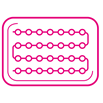 |
Combined oral contraceptive pill (COC) |
| Description | Oral hormonal contraception containing oestrogen and progestogen |
| Efficacy* | Perfect use: 99% effective | Typical use: around 91% |
| Mode of action | Prevents ovulation and stops egg and sperm meeting |
| Instructions | One pill daily for 21 days with 7-day break (to allow for monthly bleed) |
| Advantages | - Usually makes bleeds regular, lighter and less painful - May help with premenstrual symptoms - Reduces the risk of cancer of the ovary, uterus and colon - Improves acne in some people - May reduce menopausal symptoms - May reduce the risk of recurrent endometriosis after surgery - Helps with problems associated with PCOS |
| Disadvantages | - Have to remember to take a pill everyday - May get temporary side effects at first including headaches, nausea, breast tenderness and mood changes; if these don’t stop within a few months, changing the type of pill may help - May increase blood pressure - Doesn’t protect from STIs - Breakthrough bleeding (unexpected vaginal bleeding on pill taking days) and spotting is common in the first few months of use. - Slight increase risk of blood clots and breast cancer - Not recommended for use by women >50 years old - Not recommended for use while breastfeeding |
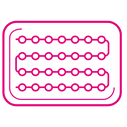 |
Progesterone-only pill (POP) |
| Description | Oral hormonal contraception containing progestogen |
| Efficacy* | Perfect use: 99% effective | Typical use: around 91% |
| Mode of action | Thickens cervical mucus to stop sperm reaching egg. Desogestrel 75microgram tablets also prevent ovulation |
| Instructions | One pill daily without breaks. Must be taken at the same time each day for contraceptive to be effective |
| Advantages | - Useful for women who cannot take oestrogen - Can use it at any age, but it's especially useful if a smoker and aged 35 or over - It may help with premenstrual symptoms and painful periods - Can be used while breastfeeding |
| Disadvantages | - Periods may change - Doesn’t protect against STIs - Have to remember to take the pill at the same time every day. - May get some side effects when first taking the POP, such as irregular bleeding, mood changes and spotty skin. These may stop within a few months - Shorter ‘missed pill’ window of 3 hours late for traditional POPs, however the ‘missed pill' window for desogestrel 75 microgram is 12 hours late |
*Perfect use if defined by FPA as using the method correctly every time; typical use is when the method is not always followed correctly.
